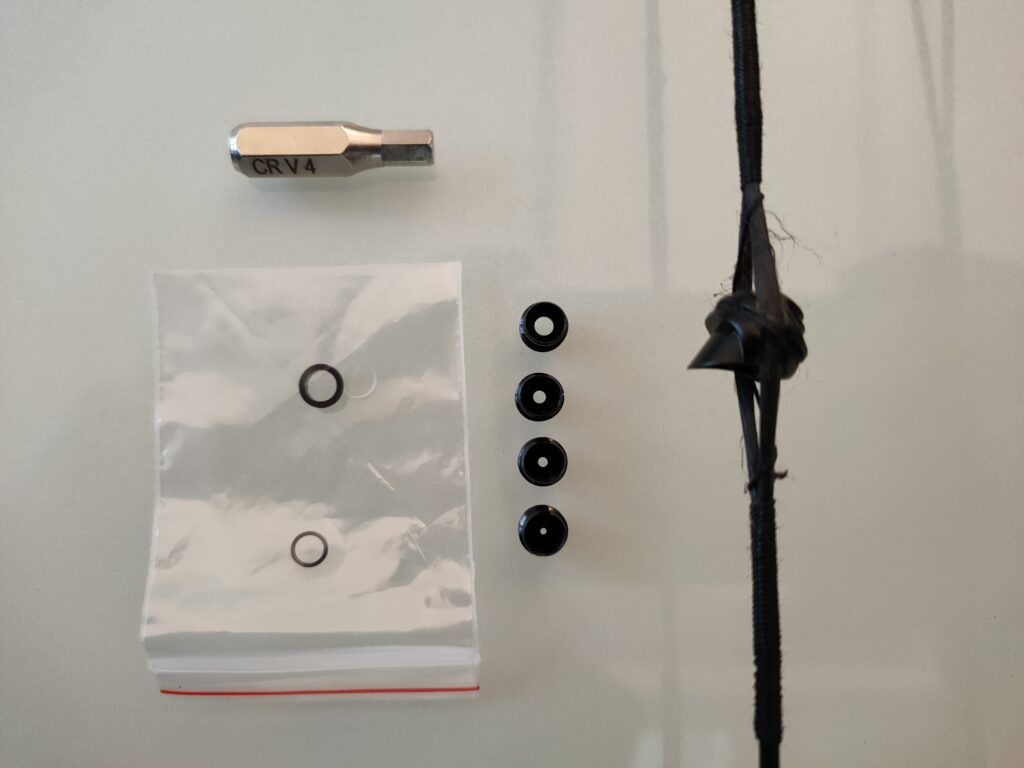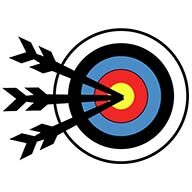The peep sight might seem like a small and insignificant piece of the bow, but it’s quite important. Together with the sight, this is the primary way you aim your bow, so buying a peep sight that fits your needs is essential.
In this article, I will provide you with the 5 best peep sights depending on your budget and needs. The first two options have an alignment tube, while the other three don’t. Later in the article, I will give some additional guidance on how to choose from these 5 options.
1. Best peep sight with alignment tube
If you are looking for an inexpensive peep sight with an alignment tube, I can highly recommend the Pine Ridge Archery Nitro Peep sight. I have recommended this peep sight a few times already in other blog posts because it is rather affordable and has a good design.
I have had some issues in the past with the alignment tube breaking near the fitting. This was caused by some sharp edges that were scraping along the tubing. Since this peep sight has a round fitting that will not happen.
The design is rather simple, so you won’t be able to change the size of the pinhole or add a clarifier. So, if you want a more premium peep sight, you might want to consider the next option.
2. Best premium peep sight with alignment tube
When you have a bit more to spend, I recommend buying this Peep sight from Limaity. The major difference between this peep sight and the previous one is the customization options.
This peep sight has threading on the inside which allows you to experiment with different pinhole sizes. It also includes a clarifier lens, which you can use when you are using a scope with high magnification.
Having all these options gives you a lot of flexibility to tune your sight picture to the way you like it. Some archers shoot with a small pinhole because this helps them to focus on the target. Other archers prefer to use the biggest option because you can see more of your surroundings.
You only know your preferences when you try it, so I highly recommend experimenting with it.
3. Best budget peep sight without alignment tube
If you prefer to shoot without an alignment tube, the Fletcher Tru Peep sight is one of the most affordable options. There is little to say about this cheap peep sight. They are simple pieces that do the job.
You can order the peep sight in multiple pinhole sizes. If you are not sure which size to choose, I would select the biggest size. Most archers prefer to have a big pinhole, because this allows you to see more of the target. Smaller pinholes are primarily used when your eyes have difficulty focusing on the target.
For a peep sight with more options and flexibility, you might want to check out the next product in the list.
4. Best medium-priced peep sight without alignment tube
Just like the second peep sight in the list, this peep sight offers you a lot of premium features for an affordable price. The kit includes 5 different pinhole sizes and a verifier lens.
Another nice feature of this peep sight is that it has a sunshield on the top. When you are on the field and the sun is shining, the glare from the sun can block your view through the peep sight. This is especially the case when you shoot with a clarifier.

This is the peep sight I currently have on my setup. The primary reason why I bought this set is because I wanted the flexibility to experiment without breaking the bank. But if you do not have a limited budget and you want the best of the best, you might want to consider the next peep sight in the list.
5. Best premium peep sight without alignment tube
If you want the best of the best, look no further than the Hamskea Archery Solutions peep sight. Hamskea is known in the world of archery as one of the most reliable and innovative archery brands in the world. Especially their arrow rest and their peep sights are popular extremely popular by professional archers.
But since this US company focused on innovation and quality, their products tend to be extremely expensive. Whether that is worth it for you depends on your needs.
If you purchase the full set from Hamskea, you will get:
- The peep sight itself
- 6 Pinhole inserts (to adjust the pinhole size)
- 4 Clarifying lenses
- Protective case
This offers you all the flexibility you need, meaning that you can completely tune the peep sight to your eyes and needs.
What you should consider when buying a peep sight
While selecting your peep sight, there are three main things to consider:
- If you want a peep sight with or without an alignment tube
- What size pinhole you want
- If you want to use a verifier or clarifier
Let’s discuss these choices one-by-one.
With or without alignment tube
The idea of the alignment tube is that it helps rotate the peep sight in the correct orientation. Peep sight rotation issues are extremely annoying and can be cumbersome to solve, especially if you do not work on your own bow.
Therefore, on beginner’s bows you often find alignment tubes because they are easier to use and require less tuning to setup. Most experienced archers prefer to shoot without peep sight tubing, because the tubing can also cause issues.
The most common issue is that the tubing breaks or slips loose. When this happens, you must replace the tube. This is quite frustrating when this happens on the field. Also, if you set up the bow correctly and you train the peep sight, an alignment tube is not necessary.
So, to summarize, I recommend using an alignment tube if you are just getting started and do not want to spend a lot of time on tuning. But if you are more experienced, you might want to replace it with a tubeless sight pin. You could even use the same sight pin if you want and just remove the tube from the fitting.
For a full explanation of all the pros and cons, including how it affects the dynamics of the bow, read my detailed article below:
Tube vs tubeless peep sight – what is better?
Pinhole size(s)
The next choice is the size of the pinhole you would like to use. If your eyes allow it, it is recommended to go for the biggest pinhole. A bigger pinhole allows you to see more of the target and gives your eyes more rest.
When you switch from shooting to retrieving the arrows, there will be more strain if you use a small pinhole. The smaller pinhole blocks more light, so on a bright day there will be a major difference. Since your pupil size must adapt to manage the amount of light, you might experience eyestrain with this configuration.
There are some good reasons to shoot with a small pinhole though. Especially if you shoot with a strong magnification, your eyes might have trouble focusing on the target. The issue is that your eyes do not know whether it should focus on the image through the sight, or everything outside.
If your eyes focus on everything outside of the sight, the sight picture itself will become blurry. By decreasing the size of the pinhole, more of the image outside of the sight picture is blocked, which helps your eyes to focus on the target.
This is highly dependent on your setup. Whether you have a large sight or a small sight. If you shoot with magnification or without. Even the size of the sight pin can have an effect. So, the only way to see what works for your eyes is to test it. That is why I recommend buying a set, where you can test with different pinhole sizes.
Verifier and clarifier
In the peep sight there are two types of lenses that you can insert:
- The clarifier corrects blurriness of the sight picture that is caused by the magnification of the sight. Our eyes struggle when they look through magnification. Because the eyes see also the sight itself and everything around it, the eyes can struggle to see the sight picture correctly. Even with a small pinhole sight, this issue can persist, especially when you have a high magnification (6x or 8x).
- The verifier corrects the blurriness of the sight pins. Since the sight pin is at a different distance than what we see through the sight picture, the sight pin can get blurry. For some people, the sight pin gets so blurry that they can hardly aim. This is especially the case for people that need reading glasses. The verifier corrects this by providing a reading glass in the sight pin.
The tricky thing is that the two options counteract each other. If you make the sight pin clearer with a verifier, the sight picture will deteriorate. The same is true for the clarifier but only in reverse. You must balance between these two evils.
If you are not experiencing any issues with the sight picture, you do not need to experiment with these two options. It is better to shoot without it if you do not need it. But if you shoot with a high magnification, most people will need to use a clarifier.
Which one I would choose
In my articles, I often like to give you all the options and let you make the decision. Just because I do it one way, does not mean that you must do it the same. Many roads lead to Rome, so I do not like to dictate what you should do.
But I got feedback from my readers that they would like to get some concrete advice on the products I offer. So here are my recommendations:
- If you are (relatively) new to archery and want to get started as soon as possible, choose the 1st peep sight if you have a low budget. Choose the 2nd peep sight if you have more to spend.
- If you are an experienced archer and want a sight with a lot of adjustment options, I recommend the 4th peep sight. If you want the best of the best and do not mind spending a lot of money, I recommend the 5th peep sight.
You might notice that I do not recommend the 3rd peep sight in any of the scenarios. I do not think there are any logical scenarios where you want to buy that peep sight. Although it is the cheapest option, it is not suitable for experienced archers, because they need more options to tune the peep sight to their liking.
Setting up the peep sight
Once you have your peep sight, you need to tie it onto the string with some serving wire. You need to secure it properly to prevent it from flying off when you release the shot. It is also critical that you fit it in the correct position and that it is not rotated.
So, when you have your peep sight, make sure to do some research on how to properly secure the peep sight. I have written a full guide on how to properly set a peep sight, which you can read below:
How to properly set up a peep sight
The article contains a lot of pictures and videos. It explains how to set up both a peep sight with and without alignment tubing.
More about the peep sights
I have written a lot of articles about peep sights. If you want to deepen your archery knowledge, click on any of the articles below:
- How to setup a peep sight
- Tube vs tubeless peep sights
- Peep sight tube broke or slips off – how to fix it
- 6 tips to fix peep sight rotation issues
Final words
While you are shopping for a peep sight, you might notice that there are a lot more options available that do not support an alignment tube. The reason for this is that most experienced archers prefer to shoot without peep sight tubing.
To be honest, both have their pros and cons, so I do not think you must shoot without tubing. When you are just getting started, it is a good idea to shoot with an alignment tube. It prevents peep alignment issues, which can be quite difficult to solve if you have little experience with working on your bow.
If you have any questions or remarks, please leave your message in the comments section below. I will reply as soon as possible and send you an email with my reply.
Tim van Rooijen
For as long as I can remember, I have always been fascinated by archery. First due to its historic significance but later because I like being outdoors. With this blog, I share my knowledge about Archery and how you can improve your shot. More about author…






